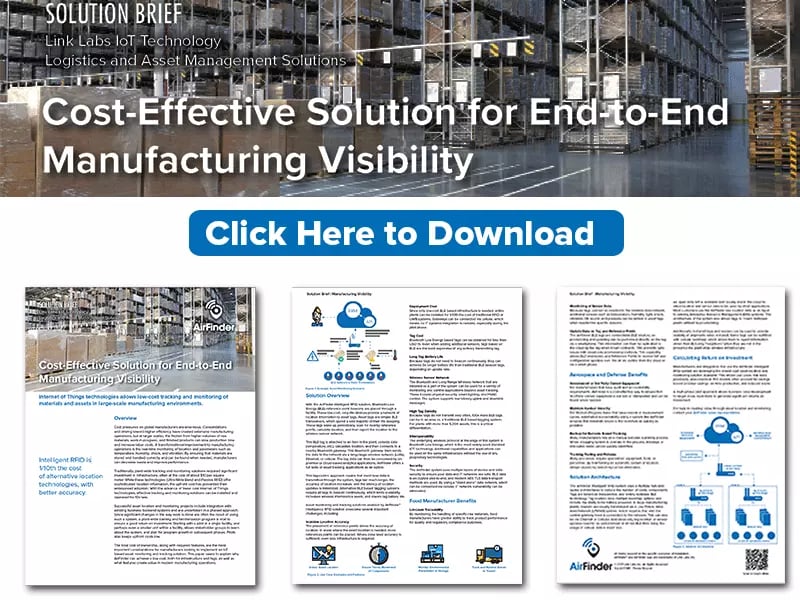Asset Tracking and Fleet Management are Key IoT Supply Chain Use Cases
Supply chain management is a foundational business process that impacts nearly every enterprise, whether you are a manufacturer that depends on moving parts into a factory and finished goods to the point of sale, or a farming operation tasked with transporting produce for processing or to commercial kitchens. Quite often, this important task involves third-party logistics companies, which, while filling an important role, can also insert inefficiency and lack of visibility into the process. Sensors that can monitor the condition of products in shipment, and cloud platforms that can optimize delivery routes are just some of the technologies that are currently disrupting the way supply chains are managed.
» Learn More: AirFinder IoT Asset Tracking System
%2020optimization.jpeg.webp?width=332&name=Supply%2020Chain%2020manager%2020Internet%2020of%2020things%2020(IOT)%2020optimization.jpeg.webp) Asset Tracking & Fleet Management
Asset Tracking & Fleet Management
Two important supply chain management use cases opened up by the Internet of Things (IoT) are asset tracking and fleet management. Asset tracking, based on RFID tags or global SIMs, for example, would allow a supply chain manager to know in real-time where a product, truck or shipping container is located; if it’s passing through the Panama Canal on a container ship or moving down an assembly line on a factory floor. This granular insight into the supply chain, when coupled with cloud computing and data analytics, can inform predictive models that allow for up-to-the-second delivery information, which, in turn, can create efficiencies in staffing levels as it relates to monitoring and receiving products, as well as the availability of complementary assets, like a crane needed to unload a barge or a forklift to load a truck.
To fully understand the impact of fleet management, consider FedEx or DHL drivers tasked with moving light-trucks filled with packages around an urban area. Factors such as weather, traffic congestion, time of day, day of the week and whether a co-worker called in sick can all change the time it takes to get the packages from a warehouse to the customer. With so many variables, it’s unrealistic to expect that a human could always make the most efficient decisions. Cloud platforms, however, being fed data from the fleet, traffic models, weather reports and other sources of insight, could always plot the best route. Not only would the packages get to the customer faster, ensuring a better end-user experience, driver headcounts could be reduced, fuel consumption decreases, as do maintenance costs, and the operator knows, based on analysis, that asset reliability, availability and efficiency are all optimized.
 Network Operators & Equipment Vendors
Network Operators & Equipment Vendors
From the perspective of network operators and equipment vendors, asset tracking and fleet management are low-hanging fruit for a number of reasons — almost every potential customer engages in some form of supply chain management, equating to a huge addressable market; also, the technology needed is well-understood, readily available and easily integrated into existing enterprise IT platforms. As with many other enterprise and industrial IoT use cases, most of the major players are approaching supply chain management with an end-to-end solution, which is meant to ease adoption for buyers by bringing a turn-key solution from a single vendor point-of-contact. While that sounds easy enough, this means the vendor, to truly bring an E2E offering, needs domain expertise in IP connectivity, cloud services, security, hardware and positioning.
LTE for IoT
Verizon, for instance, always looks to leverage its investment in a nationwide LTE network and spectrum to support IoT services such as asset tracking and fleet management. The selling point for LTE for IoT, particularly LTE Cat M1, is dependability, scalability, security, cost and long battery life for sensors and other field appliances. In fact, the operator in March beat chief rival AT&T to the activation of a nationwide LTE Cat-M1 network. The LTE Cat-M1 standard contemplates uplink and downlink speeds of a maximum of 1 Mbps, and maximum bandwidth of 1.4 megahertz per device. Verizon is partnering with Sequans to design and build Cat-M1 chips that embed Verizon’s ThingSpace IoT management platform. This would let enterprise users easily develop and deploy devices tailor-made to support their particular role in the supply chain process.
The same techniques that help a delivery driver optimize his or her route can be used to help save lives. Cisco worked with the nonprofit California Shock Trauma Air Rescue (CALSTAR) air ambulance service to bring efficiency into its dispatch system. When an emergency call is routed to CALSTAR dispatch, the public safety answering point is geo-matched to the nearest air ambulance crew, which is, in turn, dispatched. The dispatcher can speak with the ambulance crew and emergency caller through one system, which facilitates communications about arrival and lift time, as well as helps the crew prep for dynamic emergency situations. “The Internet of Everything is connecting our people, processes, and data in ways that we couldn’t do before,” CALSTAR IT Director Julie Hyde said. “The biggest change is that we have better operational control now. Operations has greater peace of mind and so do crews, because they know that our technology helps ensure their safety and security.”
Obviously, data analytics is a big part of deriving supply chain efficiency from the IoT. To better understand the role of big data, let’s look at how IBM is leveraging its Watson artificial intelligence platform to address supply chain needs. In a recent white paper, IBM noted that “as much as 65% of the value of a company’s products or services is derived from suppliers.” To overcome lack of transparency into the supply chain, the report author concludes that, “By establishing greater visibility into supply chain data and processes and leveraging cognitive technologies, supply chain organizations can both predict and mitigate disruptions and risks and deliver more value to the business.”
In terms of visibility, IBM suggests providing every supply chain stakeholder with a shared, unified view of relevant data. In a case study of customer Bonnie Plants, which provides plants to retail locations, IBM enabled “real-time visibility [which] allows the company to ship new plants where and when they are needed.” The other big piece is predictive abilities--if you can see a potential supply chain disruption coming, it’s easier to plan and mitigate. Working with IBM, KeHE Distributors modernized its logistics network to ensure operational efficiency. “In our industry, operating lean is crucial to combat downward pressure on margins,” Carl Snyder of KeHE said. “We have not experienced any unplanned downtime, keeping our logistics network running smoothly and cost effectively.”




